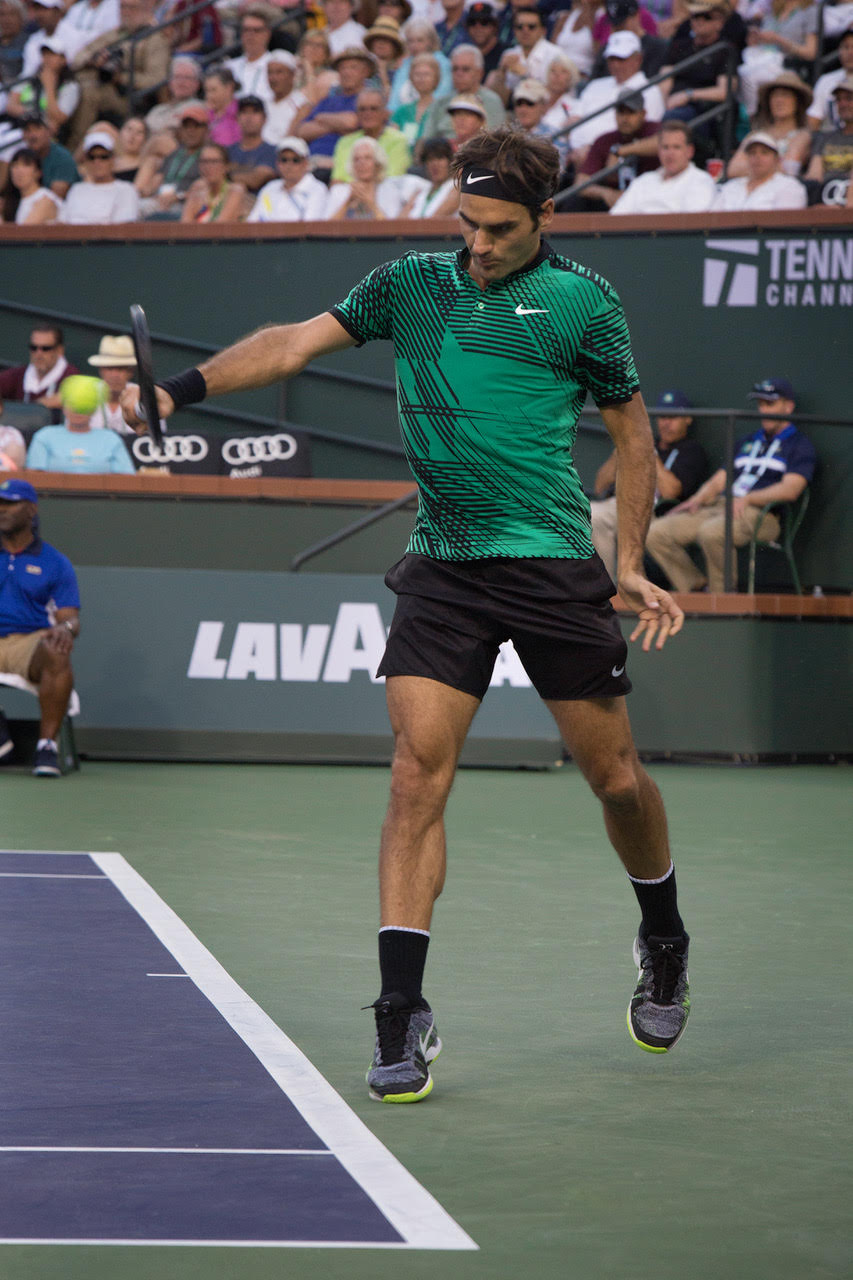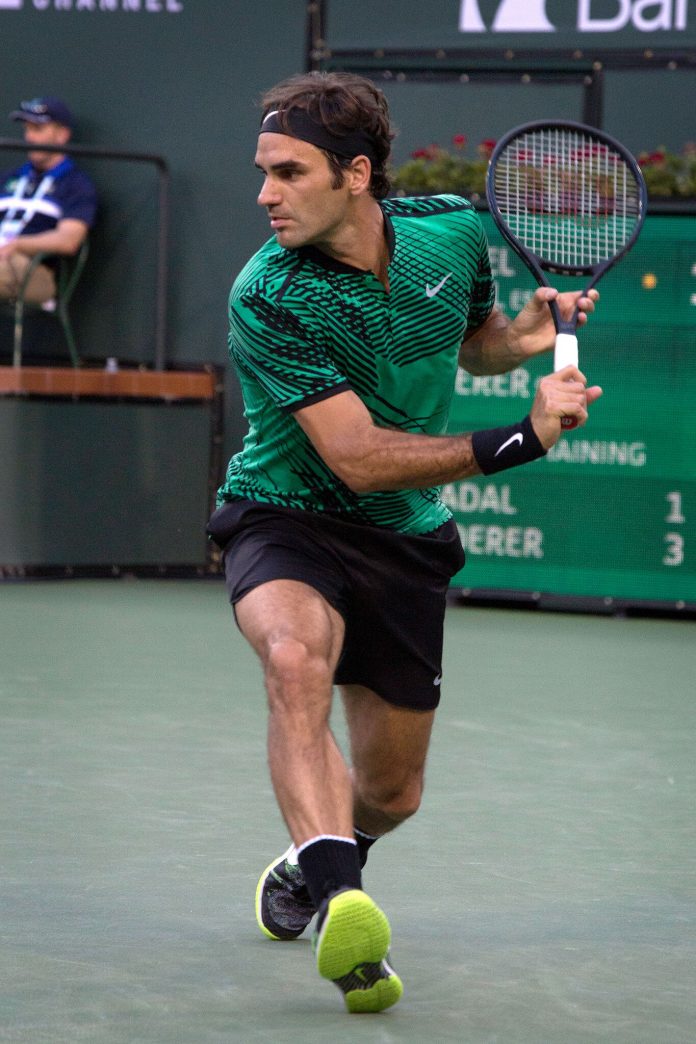CRACKLING WITH GOODNESS, FEDERER’S BACKHAND IS “BETTERER”
By Bill Simons
It’s sublime.
It flows.
It’s poetry.
It’s athletic grace incarnate. Along with Steph Curry’s sweet-release three-point jumper and golfer Phil Mickelson’s high-arcing flop shot, it’s one of the most beautiful shots in sports.
It’s Roger Federer’s backhand.
No, it’s not the most essential part of his game. His coach Sverin Luthi says the key for Federer is his serve. When it’s on, Roger gets through his service game easily, his whole game clicks. Everything comes together.
And Roger’s backhand isn’t his most powerful shot.
His quick-strike forehand may not be as “whippy” as Nick Kyrgios’ or as powerful as Del Potro’s, but it is one of the most effective in the game. As writer Richard Evans notes, “If his forehand hits the lines all the time – so what. It’s game over. And don’t forget that Roger’s forehand did inspire that immortal phrase – ‘Roger That!'”
Truth be told, for all its beauty, in much of his career, Roger’s ever-versatile backhand was often a non-factor, and famously, on clay, when Rafa cranked up his topspin forehand and bounced it high to the Swiss’ backhand, it was not a pretty picture.
But an opponent’s strengths can force even the greatest to change. Chris Evert just couldn’t keep up with fitness buff Martina Navratilova. She had to go to the gym.
Recently, Federer and his coach Ivan Ljubicic reviewed videos and saw that Roger’s backhand too often went into the net. So the strategy was to “go for it,” to attack and upgrade it.
“I had to improve it over the years,” Roger told the Indian Wells crowd. “Play aggressive and don’t want to be passive. Coming over the backhand is part of it.”
When Roger was down in the critical fifth game of the fifth set against Nadal in their classic Australian Open final this year, he hit two potent topspin backhands to the corner on Nadal’s forehand side. It turned around the most important match in tennis history since the duo’s 2008 Wimbledon final. Today Roger hit the same backhand to Nadal’s forehand corner – and secured his third straight win against the Spaniard.
There is nothing in all of sports quite like the Roger vs. Rafa rivalry. But Roger’s one-sided 1:08 6-2, 6-3 romp was an astounding, hard-to-believe anticlimax. After all, going into the match, Nadal led the rivalry 23-12, had a 12-4 record at Masters tournaments, a 9-8 record on hard courts and a 4-2 edge in the USA.
But forget the stats. Today – from Spago restaurant with its court views to the fancy suites with their toilets that reportedly cost ten grand apiece to Rod Laver in the front row, the packed audience collectively enjoyed the giddy effects of “Roger Awe.”
Time and again the Swiss pounced.
He leaned in.
He attacked.
“Roger’s backhand,” noted The Tennis Channel, “which had been his Achilles heal against Nadal, tonight was his strength.”
Federer’s backhand is far from the best in tennis. Djokovic and Murray can make that claim. Roger doesn’t even have the best one-handed backhand in Switzerland. Sorry, Dominic Thiem, Grigor Dimitrov and Richard Gasquet, Stan Wawrinka has the finest one-hander in the world. But Roger’s is plenty good, and much improved – and it is luscious. Fans love all his strokes. They adore his backhand.
Roger hits the ball high.
Roger goes cross-court.
And Rafa stumbles. Goodness – the great mover suddenly seems awkward.
Federer’s ball kisses the line. Fans go “Ahhh,” or simply offer “What a beauty!” whistles, like macho workers on a New York construction site. The Tennis Channel couldn’t help itself, saying Roger’s “backhand was insane…That was serious intent…Did that feel like 20 backhand winners in one game?” Mary Carillo said it was “crackling with goodness.”
So the only sane thing to do after Roger’s win was to ask him about the blossoming of his backhand.
He explained that with his new racquet, with its bigger head size, he is “definitely having an easier time coming over [on] the return…and staying aggressive throughout the rally. Because the racquet has more power, I have to be careful how I manage, because the ball flies out of the racquet faster than my previous racquet.”
Roger noted that it was his off-season work in November/December that made the difference.
“It’s weird,” Roger explained. “You feel like practice is paying off, because I hit so many balls. You get much more rhythm, rhythm, rhythm, and [then] eventually you play points and sets and you realize you almost don’t need all that rhythm.
“Look at the rallies today…There were hardly any normal rallies…One [shot] is a slice, one is a huge topspin, one is a block return. You never play ten backhand-to-backhand shots, but you practice those a ton and eventually they are ingrained…and you feel way better.
“The backhand…has gotten better because I have been able to put so many hours into the racquet now. Since this year, I feel super comfortable with the racquet, and I have also gained confidence stepping in…You have to take it on the rise, and for that you need good footwork, because if it is not right, you won’t be on top of the ball…All my coaches…have told me to go more for the backhand, but I used to shank [it]…Maybe deep down I didn’t always believe that I had it in the most important moments. But I think that’s changing little by little, which I’m very happy about.”
Today, a stadium of 16,000 desert fans were happy. The Mighty Federer made Rafa seem far less than mighty. The rising young Aussie Nick Kyrgios did the same thing to the tournament’s defending champion, Novak Djokovic. On Friday, Kyrgios will again play Roger, whom he beat on clay in Madrid. But Roger will try to step in and crank his new, improved, but still beautiful backhand to get back at the Aussie.




















